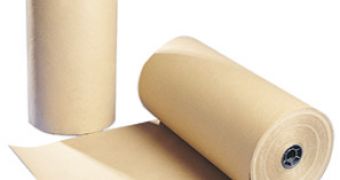Paper consists of mostly cellulose. The new biological nanopaper developed by Lars Berlund from the Swedish Royal Institute of Technology is no different, only that it is as strong as cast iron and could be used one day to create strong sticky tape or tough synthetic replacements for biological tissues and stronger conventional paper. Why not?
Cellulose is a type of sugar that makes up most of the chemical composition of the cell walls of plants. Cellulose makes about 50 percent of the structure of wood, along with other compounds. Individual molecules bind together to produce cellulose fibers some 20 nanometers in diameter to create a tough network that provides the cell wall with the required structural strength.
"Cellulose nanofibres are the main reinforcement in all plant structures and are characterized by nanoscale dimensions, high strength and toughness", said Beglund.
Most of the cellulose around the world is extracted from wood and used to make paper, cellophanes and other plastic materials. The problem is that when cellulose is extracted, the mechanical processes the wood pulp must go through destroy the cellulose fibers and, as we all know, paper isn't exactly strong. But if the extraction methods were a little gentler, most cellulose fibers would remain intact, giving paper superior strength.
The method proposed by Beglund uses enzymes to break down the wood and mechanical beaters to reduce the shearing forces that may damage the fibers. The undamaged fibers are then sorted in water, which is then drained to allow them to join together again in networks bonded through hydrogen bonds, to create nanopaper.
Mechanical tests show that the nanopaper has a tensile strength of 214 megapascals, which is rather close to that of steel and much greater than that of cast iron. The tensile strength of regular paper is some 214 times lower than that of the newly created paper, although the superior strength of nanopaper does not lie in undamaged fibers alone, but in the network structure of the fibers and the fact that they are able to slide over each other to dissipate some of the accumulated stress.
"A regular paper network has fibers 30 micrometers in diameter, here we are at a scale three orders of magnitude smaller. The material has very small defects compared with a conventional paper network", says Beglund, while revealing that the fibers of nanopaper are in fact smaller than those of regular one.
"This work shows quite clearly the potential for cellulose nanofibres to provide a basis for reinforcement", says Stephen Eichhorn, from the University of Manchester.

 14 DAY TRIAL //
14 DAY TRIAL //